Happy Feet
Today was the first time I felt well enough to ride a roadbike since having gotten sick last month. It was only 26 miles, but it felt great to have my full lung capacity and energy back.
Continuing with the Italian theme, I took Francesco - my fixed gear stallion. How happy he was, basking in the precious minutes of sunshine in between thunderstorms.
Riding a fixed gear roadbike is an experience that fills me with a special kind of enjoyment - I think because it combines the sensations of walking and flying (fly-walking?).
I was worried that I might be too out of shape to make it, but I had forgotten how comfortable Francesco is. The 26 miles of pedaling felt like a stroll in the park. Although, I have learned by now that even if I feel "fine" riding fixed gear while I am actually doing it, it does take more out of me than a free-wheel bicycle. I usually sleep longer after such a ride, and sometimes I am sore the following day.
One thing that has improved my comfort level with fixed gear cycling considerably, are these "fixie" Power Grips. I wrote about the standard Power Grips here, and since my initial review I have become addicted to these things. The fixed gear version differs from the standard model, in that it makes it easier to insert and remove your feet while pedals are in motion. I cannot tell what it is about the design that makes this possible, but none the less it seems to work. I insert my right toe at the starting position and start cycling slowly while nudging the left pedal with my left toe - then swiftly insert the toe into the left grip on the first stroke. After some practice this became a familiar and instinctive sequence of movements - though it definitely helped that I was already comfortable using this system on a free-wheel bike prior to trying it on a fixed gear.
Now that I am able to use foot retention on this bicycle, I am no longer apprehensive about cycling over bumps and potholes or going downhill at high speeds. The experience is pretty much perfect and very enjoyable. One thing in particular I have noticed, is how easy it is for me to ride "in the drops" - Francesco almost seems more stable when the handlebars are held this way than higher up. Is that possible?
And another interesting thing: I find it much, much easier to get out of the saddle and pedal standing up on Francesco than I do on my other bicycles. Is it the fixed-gearness that is facilitating this or the geometry? As I've mentioned before, I have a terrible sense of balance, and that is what I believe normally prevents me from pedaling while standing up. But on this bicycle, it seems not to matter.
It rained on and off for the duration of our ride, and the colourful leaves strewn over the trail turned into a mess of a slippery carpet. Was I so excited to be riding Francesco that I began to imagine things, or is it easier to ride in slippery conditions on a fixed gear bike? I have read comments about traction before, but I admit that I don't understand them. Could somebody explain it in layman's terms?
As I prepare for some more pruning of my bicycle overgrowth, it is clear to me that I "need" a fixed gear roadbike. So while I am now considering selling my Trek - which has been fun, but not essential - I will definitely be keeping the Francesco Moser.
In the long run, however - maybe a couple of years from now - I will probably want to replace it with a "real" fixed gear bicycle. Mainly, this is because the Moser's bottom bracket is not as high as it should be - and even though my lean on turns is not aggressive enough to warrant worrying about pedal strike yet, it would be better if this wasn't even a potential issue.
But for now, Francesco is my dashing Italian gentleman and I thank him for my happy feet.
Continuing with the Italian theme, I took Francesco - my fixed gear stallion. How happy he was, basking in the precious minutes of sunshine in between thunderstorms.
Riding a fixed gear roadbike is an experience that fills me with a special kind of enjoyment - I think because it combines the sensations of walking and flying (fly-walking?).
I was worried that I might be too out of shape to make it, but I had forgotten how comfortable Francesco is. The 26 miles of pedaling felt like a stroll in the park. Although, I have learned by now that even if I feel "fine" riding fixed gear while I am actually doing it, it does take more out of me than a free-wheel bicycle. I usually sleep longer after such a ride, and sometimes I am sore the following day.
One thing that has improved my comfort level with fixed gear cycling considerably, are these "fixie" Power Grips. I wrote about the standard Power Grips here, and since my initial review I have become addicted to these things. The fixed gear version differs from the standard model, in that it makes it easier to insert and remove your feet while pedals are in motion. I cannot tell what it is about the design that makes this possible, but none the less it seems to work. I insert my right toe at the starting position and start cycling slowly while nudging the left pedal with my left toe - then swiftly insert the toe into the left grip on the first stroke. After some practice this became a familiar and instinctive sequence of movements - though it definitely helped that I was already comfortable using this system on a free-wheel bike prior to trying it on a fixed gear.
Now that I am able to use foot retention on this bicycle, I am no longer apprehensive about cycling over bumps and potholes or going downhill at high speeds. The experience is pretty much perfect and very enjoyable. One thing in particular I have noticed, is how easy it is for me to ride "in the drops" - Francesco almost seems more stable when the handlebars are held this way than higher up. Is that possible?
And another interesting thing: I find it much, much easier to get out of the saddle and pedal standing up on Francesco than I do on my other bicycles. Is it the fixed-gearness that is facilitating this or the geometry? As I've mentioned before, I have a terrible sense of balance, and that is what I believe normally prevents me from pedaling while standing up. But on this bicycle, it seems not to matter.
It rained on and off for the duration of our ride, and the colourful leaves strewn over the trail turned into a mess of a slippery carpet. Was I so excited to be riding Francesco that I began to imagine things, or is it easier to ride in slippery conditions on a fixed gear bike? I have read comments about traction before, but I admit that I don't understand them. Could somebody explain it in layman's terms?
As I prepare for some more pruning of my bicycle overgrowth, it is clear to me that I "need" a fixed gear roadbike. So while I am now considering selling my Trek - which has been fun, but not essential - I will definitely be keeping the Francesco Moser.
In the long run, however - maybe a couple of years from now - I will probably want to replace it with a "real" fixed gear bicycle. Mainly, this is because the Moser's bottom bracket is not as high as it should be - and even though my lean on turns is not aggressive enough to warrant worrying about pedal strike yet, it would be better if this wasn't even a potential issue.
But for now, Francesco is my dashing Italian gentleman and I thank him for my happy feet.

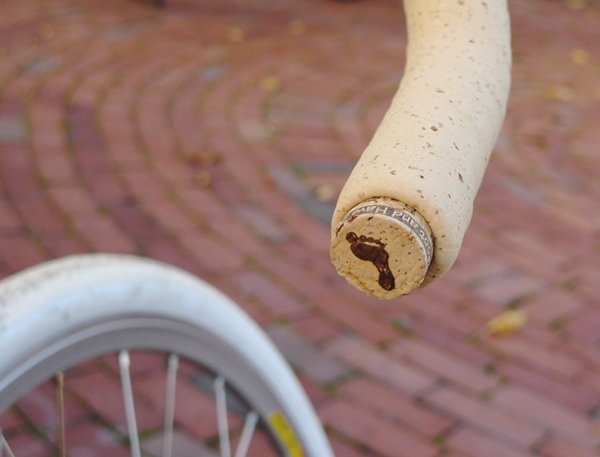

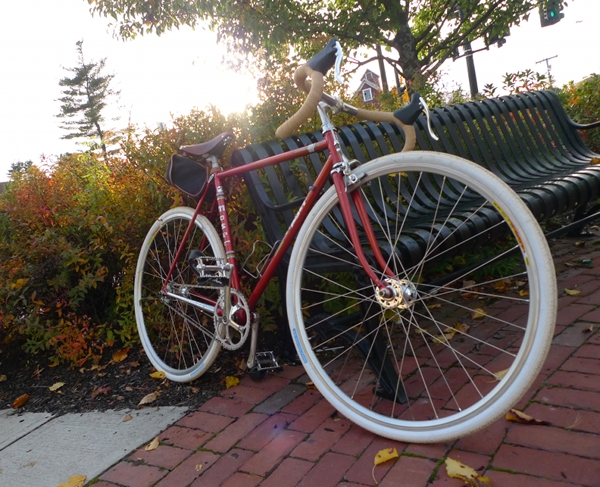

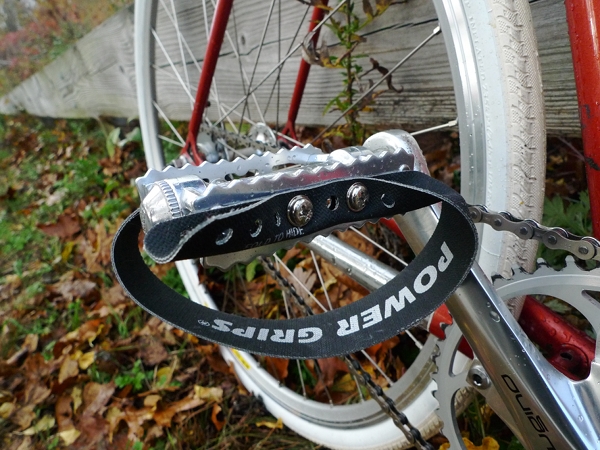

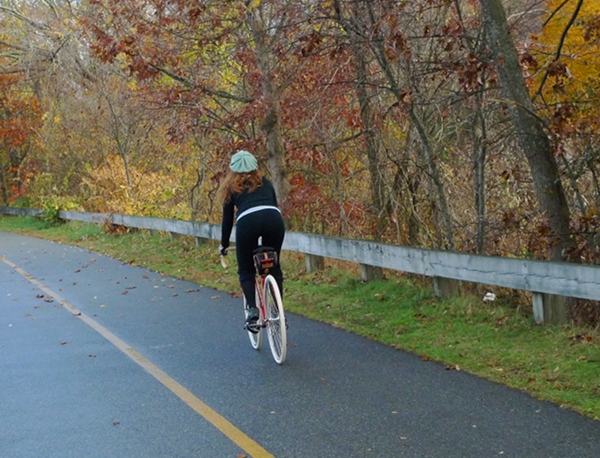
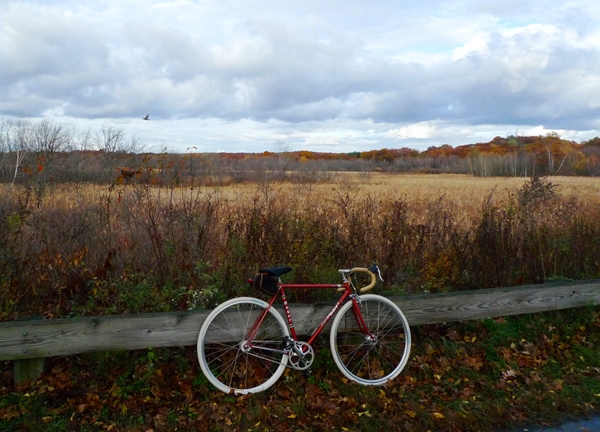
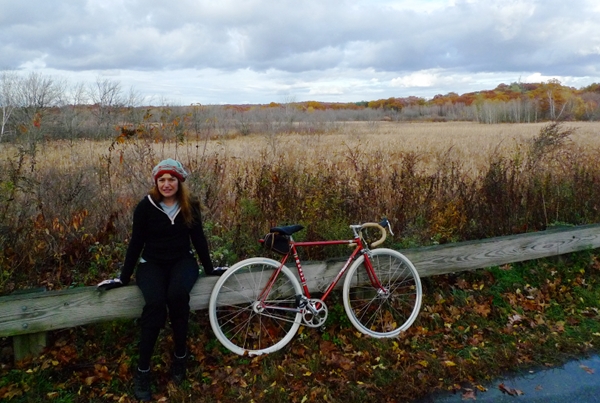

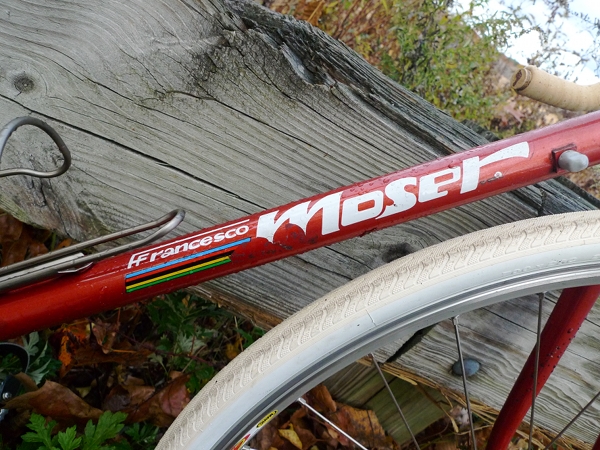
"seems more stable when the handlebars are held this way than higher up. Is that possible?"
ReplyDeleteCertainly. You have a lower center of gravity and your weight is more evenly distributed between the wheels. Just like a mid-engined Ferrari.
When first presented with drop bars most people get nervous because they they can't brake well from the tops. My answer is that if I'm going to be braking hard I'm going to be in the drops anyway, for stability reasons. It becomes automatic to go there after awhile.
"Is it the fixed-gearness that is facilitating this or the geometry?"
Yes.
"Could somebody explain it in layman's terms?"
I don't think any better than it's been done before. A freewheel creates a mechanical disconnect between your feet and the contact patch. With a fixed gear you're directly connected and it's more like that contact patch is the sole of your shoe. You both feel and control the contact better. With a freewheel you are very much operating a machine. With a fixed gear it's very much like you were born with wheels. All hail the rolling cyborg centaur.
"it would be better if this wasn't even a potential issue."
It will always be a potential issue. If you raise the bottom bracket you lose a bit of stability and the grip level of your tires will still be higher than the lean angle your pedals will allow. Well, maybe not with those tires, but with tires made for grip instead of looks.
For a road fix I advise road geometry.
Take the bike and place a crank at BDC. Now lean the bike over until the pedal hits the ground. If you look at that lean angle and think "Holy shit! How could anybody ride a bike that far over?" I wouldn't worry about it too much.
And it's really not that big a deal to scrape a pedal anyway. I've put a pedal down hard enough to lift the back wheel off the ground (including on a freewheel bike) and haven't come off . . . yet. Most people self-induce their going down by their panic reaction. Stay chill, keep 'em rolling, and you'll likely come out OK.
I agree. I've even hit a kerb with my pedal when riding fixed and stayed upright.
DeleteThe ride qualities you describe are typical of fixed-gear bikes, even if they're converted road bikes. Riding a fixed gear demands that you use more of your body, and to be more integrated with your bike. In turn, it gives you more control over your bike. So you spend more time in the drops, which makes it easier to keep your balance and to stand up, if need be.
ReplyDeletekfg - By "the drops" I mean the very tips at the bottom that run parallel to the ground; can't reach the brake levers from there.
ReplyDeleteAs for weight distribution and contact patches - forgive me, but I faked my way through AP Physics in high school and had nothing to do with it ever since. So...
Why would the weight distribution on this bike be special? I am comparing the feeling of the Moser to my other 2 bikes with drop bars. On the Rivendell I can hold the drops fairly confidently, especially when climbing, but on level ground the bike still feels best with my hands on the hoods. On the more aggressive Trek I find it difficult to keep the bike stable with my hands in the drops - for some reason I can't control the bike as well and start weaving. Initially I thought that this was because the Trek's handlebars are set lower than the Rivendell's. But the Moser's handlebars are lower still, so that can't possibly be it. Also, on the Moser it feels especially natural to stand up on the pedals and lean on those lower tips of the handlebars with my hands - something that I would never dream of attempting on a free wheel bike as I would surely fall. But anyhow, what I mean to say is that I don't understand what makes the weight distribution different than on my freewheel bikes with drop bars.
I live in the PNW and absolutely love riding in the crappy weather. I have a "beater" fixed gear with fenders and i'll never go back to riding freewheel in poor weather. The confidence you get when you can actually feel the road in your feet is unmatched. Stability around corners....I can alomst exactly predict where the slip threshold is, which is much higher by the way, due to the extra downforce and centrifugal force provided by constantly spinning the cranks. Also notice how much easier it is to climb hills, ride no-handed, and generally be a better rider? So glad you took the step and are enjoying it, keep it up!
ReplyDelete"By "the drops" I mean the very tips at the bottom that run parallel to the ground"
ReplyDeleteSure, just like in the picture. In context same diff. It'll just be a little more so when you slide forward and bend your elbows, because the operating principles are the same.
In the extreme you've got the gravity racers who remove the cranks and hang barbell weights from the bottom bracket.
"I am comparing the feeling of the Moser to my other 2 bikes with drop bars."
Well, I DID give a slightly smartass answer to the fixed vs. geometry question. Geometry is important.
The Moser isn't just a "road" bike. It's an honest to whatever road racing bike. A professional's tool optimized for the purpose.
On the other hand the Riv is just what Grant says it is, a bike good for anything but racing. Part of the Riv magic is that you can get on it, ride the hoods around the block and just know you could do that, comfortably, all day. They are designed assuming seated pedaling, moderate effort, while gripping the hoods almost all of the time. In particular the seat is set back, the bars are set up and the trail is set moderate.
The Trek, on the other hand, is a "sport" or "performance" bike. It is designed to give the impression of being a racy bike to a mass market of people who either don't actually race or only race once in awhile and have never ridden a real racing bike before. The seat is forward, the bars are low, but the trail is rather low as well, to make the bike feel "responsive." This "responsive" feel is twitchiness. It's given by making the bike UNstable.
In a real racing bike, responsiveness be good, but twitchiness be bad and shit. You have to be able to comfortably and safely ride the bike in a tightly packed peleton all day, every day. You want a bike that's stable. The average nonracer will interpret this stability as slugishness. Oh, the irony.
As well, a racing bike has to operate at its optimum while accelerating, because that's when races are won. A bike is accelerating when sprinted or when climbing; while standing, so the bike is designed to be well balanced while standing.
The seat is forward, the handlebars are low and the trail is high. It's chiefly the high trail that makes you feel stable in the drops.
velouria--I might be interested in Seymour! I've been looking for a while to add one lighter road bike to my collection of beloved but heavy English three-speeds and I think he's lovely. The vintage ten-speeds I see online all seem to be taller men's models (or really goofy 80's girls bikes in combinations of pink, lavender and aqua). If you do decide to let him go, let me know-- sarahindia at gmail.com.
ReplyDeleteThanks Sarah, I'll get in touch.
ReplyDeletekfg - Paragraphs 6 and onward - fascinating. Seriously. Hmmm...
Q - Yes, it is easier to climb hills, which is the opposite of what I had expected. It might be just an illusion - because while a free-wheel bike will coast uphill with the momentum of a previous acceleration, a fixed gear will actually "pedal on its own" uphill in the same manner, making it seem as if I need to do less work, but in reality being the same. It is a nice illusion though.
Justine - Being in the drops makes it easier to stand up? Oh...
Oh, and re pedal strike...
ReplyDelete"Take the bike and place a crank at BDC. Now lean the bike over until the pedal hits the ground. If you look at that lean angle and think "Holy shit! How could anybody ride a bike that far over?" I wouldn't worry about it too much."
Actually no; the angle isn't that great, which is what made me worried about the BB height - unfortunately after we had built up the bike. Looking at the angle, I think "Hmm, I can see how that could hit if I start to cycle more aggressively". Incidentally though, I have discovered MKS Stream pedals - which are the same as MKS Touring but narrower. So I think I'll replace mine with those if I manage to get ahold of them (surprisingly hard to get in the US) and will feel better.
BTW: What tires do you recommend, given your derision of mine? They must have puncture protection, but beyond that I am open.
"it is easier to climb hills, which is the opposite of what I had expected."
ReplyDeleteI'm always amused by people who criticize fixed gear by saying something like, "Sure, they're fine on the flats, but when you have to climb they're worthless."
These are people who have obviously never actually ridden one. Fixes climb like goats. Fast goats. In England where they take their hill climbing rather seriously people who don't otherwise ride fixed might well do so just for hill climbs. Where they're actually at a disadvantage, again counterintuitively, is descending. For really fast speeds you have to coast and tuck, which of course you can't do on a fix.
"It might be just an illusion . . ."
Yes and no. While the total work is the same a fix DOES translate momentum into force to turn the cranks over dead center. On a freewheel bike you have to use your leg muscles to move them across dead center which is less efficient in terms of translating energy into power.
The fix just rolls up the hill, while a freewheel is more like a rowing boat which surges with each oar stroke and then slows down until the oars can be brought back to bear. That's an exaggerated example, but it's significant enough that I think it's worth a couple teeth.
"Being in the drops makes it easier to stand up?"
Oh my yes. When climbing standing go right to the bar ends. It's much nicer there.
"Looking at the angle, I think "Hmm, I can see how that could hit if I start to cycle more aggressively"."
ReplyDeleteYOU, young lady, have an inner scorcher dying to get out. :) One of these days we're going to be looking at a picture of you doing a Jobst Brandt imitation.
Narrower pedals good. Shallower pedals good. Shorter cranks arms (up to a limit) better than higher bottom bracket, because it can also help you spin (for those descents or with the wind behind). It's also possible to sort of hang off the inside of the bike for shallower lean angles in harder turns (motorcycle racers often do this), but the limit of this is smaller on a fix than on a freewheel.
"What tires do you recommend"
Blacker. Back in the day all tires were white, because they were made with zinc to stabilize and harden the rubber, so they still give a certain "vintage" look. Then they discovered that carbon does a better job of it. MUCH better, giving both higher grip AND longer wear. Especially on a wet road. Carbon be black.
At the time people thought white tires looked normal and black ones "weird," so to satisfy the desire for "normality" tire makers would bond a carbon black tread to a zinc white casing; and now you know where whitewalls came from.
There's just no way around it. Tire color isn't arbitrary if you're interested in staying stuck to the road and/or getting the most mileage out of them. They've been trying for decades to create tire rubber in fashion colors that can match carbon black, but they canna change the laws of physics.
I'm not convinced that Kevlar(tm) belts do much more than make a tire heavier and stiffer. Kevlar vests stop bullets, but knives and awls go through them like butter. I could be wrong.
You like Schwalbe (and there's good reason to) and Marathon Racers, Speed Cruisers and Kojacks are all good tires.
Kfg: You've described the reasons why true racing bikes like the Moser are actually more stable when ridden at high than at low speeds.
ReplyDeleteAs for my comments about fixed gears: I meant that a fixed gear--whether it's on an actual track bike or something that was converted--does require to use more of your body in unison. At least that's been my experience in riding them (I've ridden both true "trackies" and conversions.) , and I believe it's the reason why some cyclists who have no intention of going to a velodrome train on fixed gears.
As for Kevlar belts in tires, my experience--much of it on debris-strewn urban streets-- also confirms what you say about them. I think a thicker tread, as long as it's made of durable material, will keep you riding longer without a flat than Kevlar will--especially if you ride in wet conditions. If anything goes through Kevlar like the proverbial hot knife through butter, it's a rain-slicked glass shard.
kfg - This is the angle at which I would get pedal strike. The picture was taken so that perspective is accurate. The cranks are 165mm and the pedals are MKS Touring.
ReplyDeletekfg--I think there is an established common experience by cyclists using Marathon Plus and other puncture-resistant tyres that suggests a decreased number of punctures. Also, Schwalbe tests their tyres and rates them, and from what I understand of their testing methodology it is reasonable.
ReplyDeleteAlso, I should add that I disagree with you and with others whom I've heard advocating carbon black tyres that the colour of one's rubber is going to matter at all to the casual cyclist. Are the cyclist's heart, lungs, leg muscles, diet and physique, style of riding, bicycle equipment and handling skills, experience of the route and aggressive handling so maximized that the "grippiness" of black vs coloured tyres going to have a deciding influence on one's pleasure ride, century ride, or even a quick spirited ride? Can it even be demonstrated that the friction coefficient is significantly less by sliding a coloured rubber patch on pavement and then doing the same with a black rubber patch? I'd like to hear from someone who did that and what the results were.
kfg - In my adult life, I have ridden on tires without puncture protection a total of 3 times. Each time (different tires & bikes) I got a flat. Maybe it's my luck, or maybe it's where I choose to ride the bikes. But either way, three out of three is enough for me.
ReplyDeleteKfg said:
ReplyDeleteWhile the total work is the same a fix DOES translate momentum into force to turn the cranks over dead center.
Hey, I don't understand this. So instead of the rider pushing the pedals over, the momentum of the bike does it and the rider is resisting the pedals? The rider is expending energy either way, surely it is better to expend it by rotating the pedals forwards?
Also, does this mean that the bottom-run of the chain goes alternatively tight, then slack as the cranks rotate?
Although I have not had alot of experience riding a fix, I feel that it is mainly psychological. It is not mechanically more efficient.
John I
I've ridden unprotected tires down to the cords without getting a flat, and put a tack through a protected one in less than 100 miles.
ReplyDelete"Maybe it's my luck . . ."
And maybe it's mine. That's just it. Maybe it's just luck. Cords certainly don't prevent flats, nor can I imagine any way they could cause my tack flat. Maybe they reduce the risk; maybe they're just along for the ride and to make you feel good.
I've got belted Jack Browns on the Quickbeam. I haven't gotten a flat, but maybe I wouldn't have gotten a flat with the unbelted ones either. I could try alternating sets for 100,000 miles and counting flats with each.
But here's the thing, even if I got, say, 25% fewer flats with the belted, and somehow I knew that overall puncture risk had been held constant, I STILL wouldn't know if the belts had been the cause of the lower rate.
Tell me why and win a prize.
"three out of three is enough for me."
An AWFUL lot of snake oil is sold on that basis.
Velouria-
ReplyDeleteIt's not an illusion! I have two identical frames built up, one as a fixed gear, the other a single speed. When I put the same effort into the same hill, I get up faster on the FG. It does pedal itself to an extent that you are getting a little head start on the next stroke, as opposed to having to bring it around sooner with your opposing leg. It's not a super gigantic advantage, but one that is definitely detectable.
Justine - The stabilizing force is purely reactionary and proportional (which is what makes it stabilizing, i.e. the tendency of a system when disturbed to return to its normal state. Weebles wobble, but they don't fall down). It's there at low speeds, but tiny.
ReplyDeleteThus it has another virtue beyond the mere increasing of stability with speed - feedback. The harder you push it, the more it pushes back, so you can always feel how hard you are pushing it.
MDI - "common experience . . ."
. . . says that things that are known for a fact not be are so.
". . . Marathon Plus and other puncture-resistant tyres. . ."
A)Compared to what?
B)The statement begs the question
"Schwalbe tests their tyres and rates them"
Their ratings may well be accurate, and yet not relevant. It happens.
"Can it even be demonstrated that the friction coefficient is significantly less by sliding a coloured rubber patch on pavement and then doing the same with a black rubber patch?"
Oh yeah. They've been doing it for about a century. It's no more news than wireless, at least as certain as Newton's Laws.
"I'd like to hear from someone who did that and what the results were."
No, you don't. Trust me on this one. They can go on for hours. People do this full time and with passion. There is nothing anecdotal about the claim. It is empirical. Duct tape is stickier than WD-40, and that's the way it is. It is even largely understood why. There's a fairly substantial literature about it, but brush up on your physics and organic chem. Careers, lives and billions of dollars ride on these issues.
Make a white tire that performs anywhere near a carbon black and win fame and riches. Seriously.
Velouria - "This is the angle at which I would get pedal strike."
Well damn! You need to get track pedals or something on that puppy.
re: tires:
ReplyDeleteI've never, ever flatted on marathon +s. Ever.
I've had my share of flats, and a lot of it is luck. A lot of it is the risks involved with where/how you ride. Some roads/trails have more tire hazards than others. I also used to flat a lot more when i was too inexperienced to keep my tires inflated sufficiently.
I will agree that racy tires with cursory use of kevlar are often more about marketing than about flat prevention. But, beasts like the marathon plus? I've pulled glass shards and thumb tacks out of them, no flats.
As for the color thing, mdi makes some nice points. Personally, i used to enjoy rocking off-colored tires, but gave it up b/c they never *felt* quite right. I never bothered to figure out why, but kfg's explanation makes some sense. i, for one, intend to look into it.
(It makes sense, given the 700x23c tires out there that come in about 6 different colors, but with black covering the contact patch. I always wondered why they did that. This seems like a likely answer)
-rob
"I've got belted Jack Browns on the Quickbeam"
ReplyDeleteI forgot that you owned a Quickbeam. What do you think of it as far as fixed gear goes? I am waiting for Rivendell to bring forth the Simpleone and am hoping for a low price. But given that I don't need any braze-ons or eyelets or even a rear brake, I was thinking that it may be worth it to have Royal H make it instead.
Cross post-O-Rama!
ReplyDeleteJohni - "I have not had alot of experience riding a fix"
Try it, against a SS, at near stall speed. I suspect you'll fall over on a SS where you keep going on a fix.
"does this mean that the bottom-run of the chain goes alternatively tight, then slack as the cranks rotate?"
A single track cog can cost as much as a good cassette. There are issues.
Consider this, All significant British time trial records were set on fixed. Not most. All. I'm not claiming that fixed is some sort of magical pixie dust, but clearly something positive is going on.
regarding puncture protection, my experience is that is has more to do with the brand reputation than to any stated material. for example, i've had cheap generic-branded kevlar belted tires that got a puncture right through the kevlar layer within the first 100 miles. i've also had cheap CST tires with "puncture resistant layer" that never gave me a flat. most of my bikes have schwalbe or panaracer tires with claims to some type of puncture resistance, and none of them have given me flats. i also have the original 22 year old trek-branded tires on my 1988 trek 560. they have no advertised puncture protection, yet they haven't given me a flat in the 1000-1500 miles i've ridden it since acquiring it two years ago.
ReplyDeletei also think a distinction must be made as to type of flat. not all flats can be blamed on the tire. on old bikes especially, tubes are prone to puncture from old deteriorated rim strips. this has happened to me more times than some sharp object penetrating the tire from the outside. my advice is to read reviews on different tires, and go with one that get good reviews, regardless of the puncture protection the tire claims to have.
regarding FG bikes, i have no doubt that they may be easier than a freewheel bike to ride uphill, to a degree. there is still the issue of gearing, and being able to keep a proper cadence. FG bikes don't allow this, and when it comes to really steep hills, well, sorry, but no argument can be made for FG (at least for the casual cyclist). probably at least 2-3 times a week, i smilingly pass FG cyclists walking their bikes up the steep street to my house. sometimes comments are exchanged, but usually it's a silent, knowing exchange :-).
"I forgot that you owned a Quickbeam."
ReplyDeleteYeah, well, I've mostly been defending the clunkers lately, haven't I?
"What do you think of it as far as fixed gear goes?"
Well, you have to bear in mind that what it is is a traditional English touring fixed gear. In that role it is suburb. I bought it as my primary, non-car owner, bike and if I had to cut down to one there is no question it would be the Quickbeam. It can go to the library, out for groceries, or cross country all day and is a delight to ride for any of these.
But if my primary bike were, say, a Sam, and I wanted a fix to just go out for fast rides, I might want something in a single chainring, single sidepull brake and without all the randoesque gewgaws. The Simpleone looks like it's going be a hair more to the utilitarian side with even more holes for bolts. Probably a pretty good city bike with full time fenders and Albatross bars.
I think you have an excuse to at least go have a chat with Royal H.
kfg is making me want a fixie! WTF is happening?
ReplyDeleteSomervillain - Well, for what it might be worth, I hardly recommended a FG to my 78 year old mother for her 3 mile climb up the valley wall to the grocery store. That would have been idiotic.
ReplyDeleteI recommended a single speed coaster brake. She never walks it.
But then she's not the sort of macho, youthful ijit who wont take my advice on how to gear it either.
kfg: A three-mile climb up a valley wall to the grocery store? Now there's a story I could tell my grandchildren!;-)
ReplyDeletesomervillain - when I say that a fixed gear feels easier for climbing hills, I mean when the gearing is held constant. The fixie riders you see walking their bikes up the hill where your house is probably have it geared very high, fox max speed on flat roads, whereas the bikes you ride allow for considerably lower gearing.
ReplyDeleteneighbourtease - apropos the previous post, you can always convert a vintage 3-speed : )
But anyway - I want to be like kfg's mother when I grow up...
Kfg said:
ReplyDelete>Try it, against a SS, at near stall speed. I suspect you'll fall over on a SS where you keep going on a fix.
Well I have ridden a fix during bike polo
matches, and under certain circumstances
the fix can help avoid a slow speed stall.
But do you propose that the mechanism
in effect at near stall speed is also in effect at the high cadence used during a time trial?
>All significant British time trial records were set on fixed.
That does not prove causation. That is just an appeal to authority. "All the best riders use it so it must be true".
MDI said:
>"I'd like to hear from someone who did that and >what the results were."
Kfg replied:
>No, you don't. Trust me on this one.
I think MDI is making a valid request.
Why should he just trust you?
You seem to imply that you have brushed up
on your physics and organic chem,
why not share your findings?
John I
Late to the conversation here; apologies. But have you thought about the MKS Sylvan Track pedals? Excellent ground clearance, far better than the super-wide Touring model. They're even narrower than the Road model--the "quill" design--that I have on my '72 Stella fixed-gear conversion with a 165mm crankarm, and I've never come close to striking the ground even on a tight turn. For $30, certainly worth a try before buying a whole new frame.
ReplyDeleteOne thing to think about: real track bikes have a high bottom bracket because of the very real risk of pedal strike on the steep banks of a velodrome track. This risk is greatly reduced on the relatively level ground on which most of us ride on the street.
Best of luck, whatever you decide.
johni said...
ReplyDelete"under certain circumstances the fix can help avoid a slow speed stall"
I knew there was a name for that.
Richard - I have considered them, but I would prefer 2-sided pedals. I think the MKS Streams may have the same clearance, but with the 2-sidedness I want. I may be able to pick them up this week and will be able to compare.